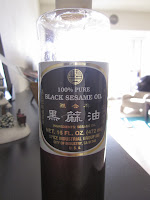I know I've grossly neglected this blog to the point of abandonment, but I have returned with one of my favorite family dishes that can't be found in any restaurant in So Cal, at least to my knowledge and believe me, I've searched. My family would make these Taiwanese burritos a few times a year during special occasions or family gatherings because it's really more fun to eat in a group with everyone taking turns at the ingredients bar. All of us would try and see who can make the biggest burrito without breaking the delicate wrap, Grandpa is the champ! It's super healthy and quite simple, but it does take a bit of work and knife skills. Just like a burrito or lasagna, this is a dish that can be altered and you can make many different versions. This is the basic veggie version, but feel free to add tofu, various meats, or other veggies to the mix.
Ingredients:
* Some of the Asian specific ingredients can be found at a specialty market, the ethnic section of your local market, or a 99 Ranch supermarket
Spring roll wrappers, don't need to be cooked, but they do dry out easily, so take them out of the packaging at the last minute and cover with a clean damp kitchen towel or wet paper towel.
Sweet chili sauce is the glue that holds the wrap together and tastes sweeter than spicy but adds just the right amount of tang and kick!
Egg & Beancurd: This is where the work starts to happen, each item needs to be prepared and finely sliced. Beat a couple eggs and poor it in a nonstick pan with a little cooking oil over medium heat. Let the egg mixture cook on one side and become a sheet, similar to an omelette, flip it over carefully and let the other side cook. Add salt and pepper remove from heat and slice into strips. Now let's talk about beancurd. What is it? It's an Asian product, specifically Chinese/Taiwanese and is basically a tofu cake made from soy beans. I often use it as a meat substitute, it's a great source of protein with a mild flavor, and can be used in a variety of ways. For this particular dish, you slice the beancurd into strips and blanche in boiling water for a few minutes, drain, and stir fry in a non stick pan with a little cooking oil, salt, and pepper.

Pickled radish: very salty and you can buy already prepared, but I like to chop even finer and toast slightly in a pan. One of my friends call them little crunchy flavor bombs!
Peanut powder: I'd choose to have this over peanut butter any day and its bascially the same ingredients just in a different texture. Finely ground roasted peanuts tossed with sugar. It's a must! Adds just the right amount of a little sweetness and it helps to absorb the moisture from the veggies so that the spring roll wrapper doesn't break as easily.
Celery, carrots, and cilantro: shredded and slices extra fine
Shredded cabbage, the main veggie. I like to julianne everything myself with a knife, I like that texture better and each veggie can still hold it's own character. If you shred it with a grater, I feel that everything becomes too mushy.
Snow peas: clean, trim, and definitely chop into strips by hand
Stir fry all the veggies together in a large wok or pan, the veggies will cook down so you might have to do separate batches
Instructions:
Pretty much all the ingredient prep is most of the work, after you finish prepping all the ingredients, lay it all out on the kitchen table with the wrappers and each person can build their own burrito. There are some basic guidelines, always start with the dry ingredients and end with the sweet chili sauce. This way the dry ingredients absorb all the veggie juices and the wrappers will break more easily when wet. See how big you can build your burrito without it breaking, though if it does break, just eat with a fork, no need to panic =) Here's how I do it, step by step...

Bite into that!


















































